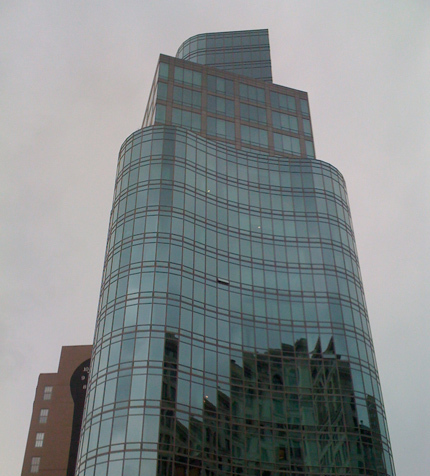
445 Lafayette Place, designed by Charles Gwathmey
People in glass apartments shouldn’t throw stones or other projectiles. Nor should they engage in private acts directly in front of their floor to ceiling windows. Yet lately there has been a rash of exhibitionism throughout New York City owing to an increase in floor to ceiling windowed buildings. Influenced in part by Richard Meier’s glass box towers in lower Manhattan (and his newest one at One Grand Army Plaza in Brooklyn), these transparent living spaces, once the quintessence of twenty first century Modernism, have become eyesores, particularly at night when they take on the appearance of showrooms in Amsterdam’s red light district.
How often have you walked down streets where you’ve seen much more of another person’s life and lifestyle than necessary? Yet like a moth drawn to light you couldn’t resist?
You’d think there should be a law. Indeed there are peeping Tom statutes on the books. A Tom is a person who, according to uslegal.com, “stealthily peeks into windows, other openings with the purpose of getting a sexual thrill from seeing women or girls undressed or couples making love. It is a slang term for a voyeur. Being a peeping Tom is treated as a crime based on sexual deviancy, according to state laws, which vary by state. The victim of a peeping Tom can bring a lawsuit for invasion of privacy.”
Granted simply walking down the street and inadvertently peering into a window does not constitute “secret or surreptitious” trespassing on another’s privacy, but it does beg the question: Why would anyone want their intimate life exposed to any peeping Tom, Dick or Harry? In other words, what were the architects thinking? And why are so many developers buying into this aesthetic?
In the 1949 film version of Ayn Rand’s over-wrought The Fountainhead, starring Gary Cooper as the “visionary” architect Howard Roark, a residential skyscraper looms over Central Park with its terraced glass facade shimmering in the sun. The structure represented the victorious struggle of iconic Modernism over tired classicism. It further symbolized Rand’s ideal of the supreme individualist combating mass conformity. Any high school and college student aspiring to iconoclasm envies Roark’s tenacious insistence on artistic integrity — the integrity of the devout modernist for whom rightness of form trumps the needs of many. Curiously his fictional buildings, perversely rooted in Bauhaus aesthetics, reveal a preference for glass curtain walls, which in real life on Park Avenue in the sixties added luster to the old boulevard. But now that such buildings are sprinkled all over the city and throughout the boroughs the result is not radical but bourgeois conformity.
I will leave the critique of structural virtues of floor to ceiling fashion to architects. I accept that living space, even in these troubled economic times, is expensive and the glass wall enables architects to give the illusion of more height and breadth in otherwise small apartments. I also accept that at the architectural scale-model-stage, these exteriors are quite impressive, especially when the glass punctuates the monotony of an average brick and mortar streetscape. But inhabited buildings are never as pristine as the model, not everyone has the same window coverings (if at all.) Often furniture, which would ordinarily be placed in front of walls are backed up to the windows. Moreover, I’ve passed buildings where residents have even thrown up bed sheets to block out the sun and unwanted gazes. But most of the apartments in my neighborhood do not even attempt to cover-up. Speaking as an involuntary peeping Tom the windows are invitations for leering and are as provocative as the sensational photographs and headlines on the New York Post.
I asked a neighbor who lives on the fifth floor in one glass front building why he allows his family to be so exposed. “Well, we paid for the windows,” he replied, “and we like the light, the view of the street, and didn’t really think that people would even want to look in.” But they do, so how do you feel about a stranger’s gaze? “Well, we are careful not to run around naked, but that’s a small price to pay for the airiness.” Still, don’t you feel like you’re in a fish bowl? And doesn’t that make you feel self-conscious? “Well, for now its fine, maybe in a few years we’ll be sick of it and decide to sell.” Then one final question, is there any pressure from the building or your neighbors to maintain your windows in a specific way to insure the integrity of the design? “Well, it was suggested that we not hang heavy drapes, or shades that were not white. But that makes sense given the environment we chose to live in. No one has told us what sofa or lamps to buy, it’s not like company housing. What’s the big deal, anyway?"
This is as far from company housing as possible, but the floor to ceiling window policy invites unwanted company. A more traditional window treatment means there are more options to be open or closed, revealed or concealed. Floor to ceiling windows also produces visual clutter that ultimately conflicts with the architectural transparency. So, what’s the big deal? These buildings, especially at night, add to the chaos of the street. Too much visual information is not good design. Floor to ceiling is certainly in, but I’m tired of looking in — I’ll close my eyes, but you close the blinds.


Comments [28]
I'll stay with the fray. Thank you.
(As for a "solution" to keep your eyes out of their homes? May I suggest the ricepaper ideal of Japanese homes -- floor to sealing light but with privacy.)
10.23.09
08:35
Yes, I'm dismayed by it (gawd knows i wouldn't want to be caught dead nude infront of my neighbors) but am probably more appalled by the things people expose while talking on their cell phones so go figure.
I'm assuming the glass towers are collection spots for everyone yelling "... and then, OMG, he asked me to do XXX and I was like gross but then, ya know, i DID!" as they walk down Lex.
The issue of why are they so ass ugly (the towers - its self-explanitory for the aforementioned residents) is likely independent of their occupation: Gwathmey's Astor Place Toad would look ghetto in SimCity, let alone real life, and having modest residents wouldn't make a whit of difference...
10.23.09
10:31
Very amusing Steven — it is all in your point of view. When I was a student at Cooper Union 445 Lafayette Street was a parking lot. Today the residents of Astor Place, 445 Lafayette Street will look over at Cooper Union and see both the historic foundation building and the CU Alumni celebrating their new building at 41 Cooper Square. It is one of New York City’s outstanding green buildings.
Preview: The Cooper Union
A Tough and Sexy Statement
10.24.09
07:02
10.24.09
07:04
"Who wants windows?" Mr Twit had said when they were building it. "Who wants every Tom Dick and Harry peeping in to see what you’re doing?" It didn't occur to Mr Twit that windows were meant mainly for looking out of, not for looking into.
10.24.09
10:17
10.24.09
11:32
10.24.09
11:58
I agree with your point that this trend of floor-to-ceiling windows constitutes a fad and will most certainly look dated one day.
But about the lack of "visual conformity" and abundance of chaos that they bring? Isn't NYC itself a huge experiment in architectural heterogeneity? In a way aren't these buildings reflections of what's going on all around the city?
Having said that I live in San Francisco and haven't seen any examples of these buildings in action, so perhaps I'd balk in "real life." The concept that people living within the building literally change the design, a sort of "living design" is an interesting concept nonetheless.
10.24.09
04:14
10.24.09
08:26
cry me a glass river.
10.25.09
11:13
10.25.09
01:03
10.25.09
04:39
glass office buildings, especially those done by mies successor firms, include lease requirements that dictate the lighting pattern, ceilings and colors within 15 or 20 feet of the facade as well as uniform window coverings. why not residential buildings as well
10.26.09
01:18
http://www.standardhotels.com/new-york-city/
10.26.09
09:31
10.26.09
11:38
10.26.09
11:58
10.27.09
03:12
10.28.09
10:35
10.28.09
12:36
10.28.09
04:54
10.29.09
01:13
Glass buildings are not green. Making the glass takes a lot of energy, and there are chemical compounds in them which in a couple of decades will wear out so that the glass wall will have to be replaced. That's wasted energy 2x.
Buildings with thermal mass are more energy efficient.
On the whole, the greenest building is the building that lasts the longest. Preserving an old building, rather than tearing it down, conserves an enormous amount of energy and materials.
The Times had a story on the destructive effects of the western sun. Put a fabric behind a west-facing glass wall and you can bleach the fabric in just a few months.
Rooms with glass walls are difficult to furnish. You don't want to block the view, and furniture looks silly in front of a glass wall.
Last but definitely not least, all the best streets in New York are made with masonry buildings defining the street walls -- if you don't believe that, show me the exception.
Glass buildings don't have to be terrible at making a street wall and defining the public realm, but they often are, particularly with the current fashion for flush walls and graphpaper-like repetive patterns.
The buildings that make the best street walls have mass, depth that produces light and shadow, rhythm, composition, and vertical windows rather than horizontal.
11.10.09
10:11
Just yesterday I was admiring the Cooper Square Hotel - and decrying the new Thom Mayne building for Cooper. As usual, design can solve problems or cause them.
When THOR (The Hotel On Rivington) first opened, I spent 3 enjoyable nights there, and if I can get a better rate at the Cooper Square Hotel, I might spend a night there too. These glass rooms are a nice place to visit, even if I don't want to live there.
11.10.09
10:19
thanks
03.04.10
11:41
And with these tints and shades, apartments and homes are more energy efficient. The UV rays are blocked.
Yes, you can have both.
And it's not okay to put furniture in front of the glass? huh?
04.21.10
05:19
06.08.10
11:34
John Massengale, I agree entirely. One of my favorite streets (as far as architecture) in this city is Wall Street. With all the glass popping up around the Financial District, it's nice to see architecture that doesn't look so......"temporary", for lack of a better word.
06.09.10
01:42
03.21.11
10:30